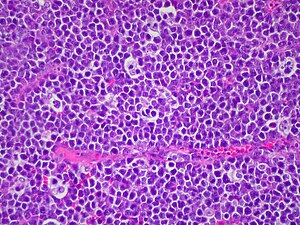Burkitt lymphoma
Jump to navigation
Jump to search
Burkitt lymphoma, abbreviated BL, is an uncommon lymphoma with medium-sized cells.
| Burkitt lymphoma | |
|---|---|
| Diagnosis in short | |
 Starry-sky pattern. H&E stain. | |
|
| |
| LM | medium-sized lymphoid cells of uniform size with abundant cytoplasm, interspersed macrophages |
| Subtypes | endemic, non-endemic, immunodeficiency associated |
| LM DDx | DLBCL, intermediate DLBCL/BL |
| IHC | CD20+, CD10+, BCL6+, EBER+, Ki-67 (100%) |
| Molecular | t(8;14) (q24;q32) + others |
| Site | lymph node |
|
| |
| Associated Dx | +/-EBV infection, +/-HIV infection |
| Clinical history | very rapid growth |
| Prevalence | uncommon |
General
- Extremely high proliferative rate & rate of apoptosis.
- Rare in adults -- 1-2% of adult lymphomas.[1]
- Relatively common in children -- 30-50% of childhood lymphomas.[1]
Pathophysiology
- Origin cell: germinal centre B cells (favoured) vs. memory B cells.[2]
Subtypes
- Three subtypes recognized:[2]
- Endemic:
- Found in Africa.
- EBV (Epstein-Barr virus) associated.[2]
- Non-endemic:
- Typical of the BL seen in the western world; EBV negative.
- Immunodeficiency associated:
- Associated with HIV infection.
Microscopic
Features:
- "Starry-sky pattern":
- The stars in the pattern are: tingible-body macrophages.
- Tingible-body macrophages = macrophages containing apoptotic tumour cells.
- The tumour cells are the sky.
- The stars in the pattern are: tingible-body macrophages.
- Tumour cells:[2]
- Medium-sized (~1.5-2x the size of a RBC) with uniform size ("monotonous") -- key feature.
- Round nucleus.
- Small nucleoli.
- Relatively abundant cytoplasm.
- Brisk mitotic rate.
DDx:
- DLBCL.
- B cell lymphoma unclassifiable with features intermediate between DLBCL and Burkitt lymphoma.[3]
- May be referred to as intermediate DLBCL/BL.[4]
Images
www:
Cytology
Features:
- Medium-sized lymphoid cells with small lipid vacuoles (~1-2 micrometers).[5]
Image:
IHC
Features:
- CD20 +ve.
- CD10 +ve.
- BCL6 +ve.
- EBER +ve.
- Ki-67 ~100%.
Others:
- BCL2 -ve.
Molecular pathology
- t(8;14) (q24;q32) translocation.[2]
- Several other variants -- involve MYC rearrangement.[2][1]
Note:
- MYC rearrangement is typically assessed with an ISH break apart probe.
See also
References
- ↑ 1.0 1.1 1.2 Online 'Mendelian Inheritance in Man' (OMIM) 113970
- ↑ 2.0 2.1 2.2 2.3 2.4 2.5 Bellan C, Lazzi S, De Falco G, Nyongo A, Giordano A, Leoncini L (March 2003). "Burkitt's lymphoma: new insights into molecular pathogenesis". J. Clin. Pathol. 56 (3): 188–92. PMC 1769902. PMID 12610094. http://jcp.bmj.com/cgi/pmidlookup?view=long&pmid=12610094.
- ↑ Carbone, A.; Gloghini, A.; Aiello, A.; Testi, A.; Cabras, A. (May 2010). "B-cell lymphomas with features intermediate between distinct pathologic entities. From pathogenesis to pathology.". Hum Pathol 41 (5): 621-31. doi:10.1016/j.humpath.2009.10.027. PMID 20398809.
- ↑ Ahn, JY.; Seo, YH.; Park, PW.; Kim, KH.; Park, MJ.; Jeong, JH.; Park, SH.; Song, YH. (Mar 2012). "A case of B-cell lymphoma, unclassifiable, with features intermediate between diffuse large B-cell lymphoma and Burkitt lymphoma in a Korean child.". Ann Lab Med 32 (2): 162-6. doi:10.3343/alm.2012.32.2.162. PMID 22389885.
- ↑ Troxell, ML.; Bangs, CD.; Cherry, AM.; Natkunam, Y.; Kong, CS. (Oct 2005). "Cytologic diagnosis of Burkitt lymphoma.". Cancer 105 (5): 310-8. doi:10.1002/cncr.21307. PMID 15986398.